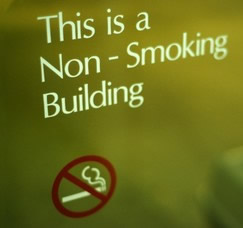Feb 9 2005
 College campuses provide a captive audience for cigarette-makers, but a new review of tobacco intervention studies suggests that universities are also effective sites for anti-smoking efforts.
College campuses provide a captive audience for cigarette-makers, but a new review of tobacco intervention studies suggests that universities are also effective sites for anti-smoking efforts.
The review found ample evidence that quit-smoking programs and other interventions can change attitudes and reduce tobacco use among college students, lead author Rebecca Murphy-Hoefer said. Some of the better results came from "environmental" interventions – like no-smoking zones, anti-tobacco advertisements and smoking-restricted dormitories.
Anti-tobacco and quit-smoking campaigns should also enlist the help of campus resources – among them residence and academic advisors; coaches; and student health centers, the review recommends.
"First and foremost, the research shows that even smokers appreciate smoke-free policies," she said.
Murphy-Hoefer and colleagues in the Office on Smoking and Health at the Centers for Disease Control and Prevention conducted the review, which appears in the February issue of the American Journal of Preventive Medicine.
The researchers looked at 20 years of tobacco-intervention studies aimed at college and university students and selected 14 studies that had strong statistical merit. Differences in the design of the studies and a dearth of rigorous research made it impossible to draw hard conclusions on the most effective tobacco-reduction strategies, Murphy-Hoefer says.
Still, the CDC review does reveal clues about what works and suggest new research paths – especially those that include larger participant pools and control groups.
A 1999 study at Ursinus College designed to reduce public smoking reports 35 percent fewer cigarette butts found in campus buildings after "Think. Why Smoke?" messages were posted at the university.
A 1997 study found 28 percent of men and 30 percent of women smoking less after smoke-free policies were implemented at a German university, and 91 percent of nonsmokers and 68 percent of smokers approved of the new restrictions.
Among adults in the United States, young people age 18 to 24 have the highest prevalence of cigarette smoking -- 28.5 percent versus 22.5 percent for all adults.
"There is evidence that the tobacco industry is targeting this age group ," Murphy-Hoefer says.
Tobacco advertisers aim at students through college newspapers, bar and club promotions and free samples, and these outlets are good starting points to measure the effect of anti-tobacco messages and other intervention tactics, the review says.
Murphy-Hoefer says successful campus-based interventions could also shape the perceptions of younger people who view college students as role models.
"Actually the smoking rates are higher among 18-to-24 years olds who are not in college, but we don't know how to reach them yet," she says.